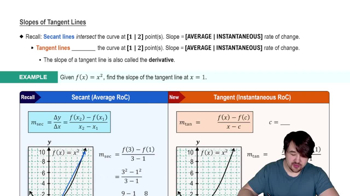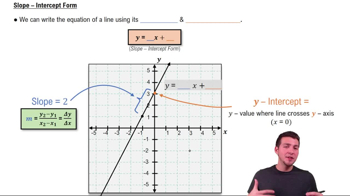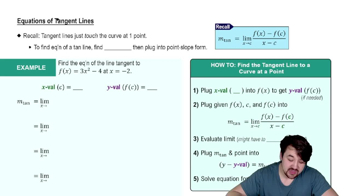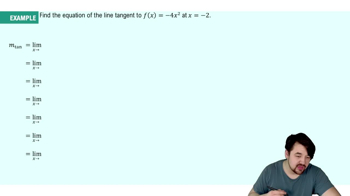Table of contents
- 0. Functions7h 52m
- Introduction to Functions16m
- Piecewise Functions10m
- Properties of Functions9m
- Common Functions1h 8m
- Transformations5m
- Combining Functions27m
- Exponent rules32m
- Exponential Functions28m
- Logarithmic Functions24m
- Properties of Logarithms34m
- Exponential & Logarithmic Equations35m
- Introduction to Trigonometric Functions38m
- Graphs of Trigonometric Functions44m
- Trigonometric Identities47m
- Inverse Trigonometric Functions48m
- 1. Limits and Continuity2h 2m
- 2. Intro to Derivatives1h 33m
- 3. Techniques of Differentiation3h 18m
- 4. Applications of Derivatives2h 38m
- 5. Graphical Applications of Derivatives6h 2m
- 6. Derivatives of Inverse, Exponential, & Logarithmic Functions2h 37m
- 7. Antiderivatives & Indefinite Integrals1h 26m
- 8. Definite Integrals4h 44m
- 9. Graphical Applications of Integrals2h 27m
- 10. Physics Applications of Integrals 2h 22m
2. Intro to Derivatives
Tangent Lines and Derivatives
Problem 3.40b
Textbook Question
Derivatives and tangent lines
b. Determine an equation of the line tangent to the graph of f at the point (a,f(a)) for the given value of a.
f(x) = √3x; a= 12
 Verified step by step guidance
Verified step by step guidance1
Step 1: Identify the function and the point of tangency. The function given is \( f(x) = \sqrt{3x} \) and the point of tangency is \( (a, f(a)) \) where \( a = 12 \).
Step 2: Calculate \( f(a) \). Substitute \( a = 12 \) into the function to find \( f(12) = \sqrt{3 \times 12} \).
Step 3: Find the derivative of the function \( f(x) = \sqrt{3x} \). Use the chain rule: \( f'(x) = \frac{d}{dx}(3x)^{1/2} = \frac{1}{2}(3x)^{-1/2} \cdot 3 \).
Step 4: Evaluate the derivative at \( x = 12 \). Substitute \( x = 12 \) into \( f'(x) \) to find \( f'(12) \).
Step 5: Use the point-slope form of a line to write the equation of the tangent line. The formula is \( y - f(a) = f'(a)(x - a) \). Substitute \( f(12) \) and \( f'(12) \) into this equation.
 Verified video answer for a similar problem:
Verified video answer for a similar problem:This video solution was recommended by our tutors as helpful for the problem above
Video duration:
6mPlay a video:
Was this helpful?
Key Concepts
Here are the essential concepts you must grasp in order to answer the question correctly.
Derivative
The derivative of a function at a point measures the rate at which the function's value changes as its input changes. It is defined as the limit of the average rate of change of the function over an interval as the interval approaches zero. In practical terms, the derivative at a point gives the slope of the tangent line to the graph of the function at that point.
Recommended video:

Derivatives
Tangent Line
A tangent line to a curve at a given point is a straight line that touches the curve at that point without crossing it. The slope of the tangent line is equal to the derivative of the function at that point. The equation of the tangent line can be expressed in point-slope form, which is derived from the slope and the coordinates of the point of tangency.
Recommended video:

Slopes of Tangent Lines
Point-Slope Form
The point-slope form of a linear equation is given by y - y₁ = m(x - x₁), where (x₁, y₁) is a point on the line and m is the slope. This form is particularly useful for writing the equation of a tangent line once the slope (derivative) and the point of tangency are known. By substituting the appropriate values, one can easily derive the equation of the tangent line.
Recommended video:
Guided course

Slope-Intercept Form

 5:13m
5:13mWatch next
Master Slopes of Tangent Lines with a bite sized video explanation from Nick
Start learningRelated Videos
Related Practice



